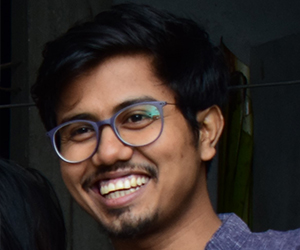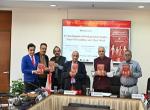On June 24, the Vivekananda International Foundation (VIF) organized a talk on ‘The Indic Religious Tradition and the Philosophical Tradition of India’ by Prof. Arvind Sharma, Birks Professor of Comparative Religion in the School of Religious Studies at McGill University in Montreal, Canada and formerly part of the Indian Administrative Service (IAS). This was the second talk in the series of lectures and discussions on Indic religious traditions. Dr. Arvind Gupta, Director, VIF, delivered the opening remarks in which he briefly talked about the important Dharma is to Indic traditions.
In his keynote address, Prof. Sharma explained the expression "nānādharmāṇaṁ Janaṁ bibhratī" from the Pṛthivī Sūkta of the Atharva Veda. This phrase describes the earth as supporting people following different dharmas, highlighting the concept of nānā-dharma, or diverse modes of life. The term nānā-dharma captures the essence of what is often referred to as pluralism in contemporary discourse. The lecture explored the nuances of pluralism, its historical context, and its relevance to the Indic religious traditions, especially Hinduism.
The term pluralism in modern discourse often implies diversity among different religions. However, the word can be misleading as it may also suggest uniformity, like identical clones of an object. Therefore, it is essential to use the term with an understanding that it denotes religious diversity, not uniformity. The lecture emphasized that pluralism should not be reduced to a mere buzzword, which is a term used to impress without substantial meaning. Instead, it should be recognized as a significant contemporary phenomenon, reflecting the increasing interaction and exposure among world religions.
John Hick provides a historical backdrop for understanding pluralism. Until recent times, religions developed in isolation from each other, with occasional expansions leading to interactions, often marked by conflict rather than dialogue. Major expansions included Buddhism's spread across Asia, the rise of Hinduism, the spread of Christianity in the Roman Empire, and the expansion of Islam. The last century has seen a scholarly appreciation of different religions, highlighting the conflicting truth claims made by various traditions and bringing religious pluralism to the forefront of philosophical discussions.
Pluralism should be understood in relation to exclusivism and inclusivism. Exclusivism posits that one's own religion is the sole true path to the divine. Inclusivism acknowledges the presence of the divine in other religions but views one's own religion as the definitive revelation. Pluralism, on the other hand, places the divine at the centre of all faiths without prioritizing one over the others.
Applying these terms to Indic traditions reveals interesting dynamics. For example, Hindu exclusivism, as described by Wilhelm Halbfass, presents India (Bharata) as the exclusive land of dharma and religious rituals. Yet, this view is not representative of Hinduism as a whole. More inclusive perspectives, like those of S. Radhakrishnan, emphasize the shared metaphysical and moral perfections among various deities and names used for the Absolute Reality. Such inclusivism, however, might be seen as a hierarchical accommodation rather than genuine pluralism. S. Radhakrishnan's interpretation of Hinduism promotes an inclusive approach, recognizing the divine in multiple forms and names. Radhakrishnan's view can be seen as either pluralistic or inclusivistic. A more comprehensive statement of Hindu pluralism is offered by Albironi, who noted that according to some Hindu philosophers, liberation is accessible to all castes and humanity if pursued with the right intention. This broad inclusivity contrasts with more restrictive views within the tradition.
Conflict resolution is integral to pluralism, with strategies such as pragmatism, staging, levelling, and teaching contradictions. Hinduism employs various techniques to manage religious pluralism:
- Pragmatism: Focusing on immediate practical steps rather than distant uncertainties.
- Staging: Organizing life into stages (Brahmacharya, Gārhasthya, Vānaprasthya, Saṁnyāsa) that accommodate both worldly and spiritual goals.
- Levelling: Addressing issues at different levels, such as physical and mental renunciation in the Bhagavad Gita.
- Options and Contradictions: Treating conflicting Vedic injunctions as optional rather than contradictory.
- Substitution, Hyphenation, Equivalence: Introducing new elements without eliminating old ones, creating compound identities, and establishing equivalence without ambivalence.
Other methods like substitution, hyphenation, and equivalence demonstrate the complexity and authenticity of conflict resolution in Hinduism. For instance, Ramanuja’s concept of Ubhaya-Vedanta established the equivalence of the Vedas and the devotional Tamil hymns, promoting inclusivity within the tradition. The social impact of these resolutions is significant. Equivalence of texts, like the Nalayira-Prabandham with the Vedas, challenges traditional restrictions and promotes broader inclusion. This approach exemplifies the principle of drawing a wider circle to include others, fostering a more inclusive religious environment.
When discussing Hinduism as a tolerant religion, it’s important to acknowledge the presence of exclusive elements but recognize the predominance of inclusivist and plural elements. This framework can also be applied to Buddhism, Jainism, and Sikhism, though their patterns of exclusivism, inclusivism, and pluralism would largely mirror those identified in Hinduism.
Buddhism's approach to pluralism is illustrated by the parable of the blind men and the elephant. Each blind man describes the elephant based on the part they touch, leading to partial truths and conflict. The Buddha uses this story to emphasize that while each perspective is valid, it is incomplete without recognizing the broader truth. This highlights the need for humility and openness to different perspectives.
Jainism adopts a similar stance, as explained by Professor J. Long. The story of the blind men and the elephant is used to demonstrate that while each person's perception is valid, it is limited. Only a Jaina, or enlightened being, can see the whole truth. This Jain doctrine underscores the importance of acknowledging and respecting multiple viewpoints to approach a more comprehensive understanding of reality.
Prof. Arvind Sharma concluded his talk by reiterating the multifaceted nature of pluralism in Indic traditions. Hinduism, Buddhism, and Jainism all exhibit various strategies to manage and embrace religious diversity. The attitudes of Hinduism, Buddhism, and Jainism towards pluralism highlight a rich tapestry of conflict resolution. These traditions emphasize practical approaches, staging of life goals, recognizing different levels of truth, and incorporating new elements while respecting existing ones. The overarching theme is one of inclusion, humility, and respect for diverse perspectives, providing a rich history of pluralism that can offer valuable insights for contemporary interfaith dialogue. These traditions demonstrate that pluralism involves not only recognizing diversity but also actively engaging with and accommodating it in meaningful ways. By examining these approaches, we can better appreciate the complexities and nuances of religious pluralism in the modern world.
In agreement with Prof. Arvind Sharma, Gunjan Pradhan Sinha talked about pluralism in India in which many religions adopt different techniques to reach sometimes the same conclusion or different conclusions. Dr. Sandipani Dash highlighted the distinction between plurality and pluralism and that there is no one way in which people perceive oneness, which results in inclusivity or exclusivity. Swami Sarvalokananda talked about the common objective of all religions and that there is only one truth but it can be realised in different ways. The session was then open for discussion followed by closing remarks by Dr Arvind Gupta.







Post new comment